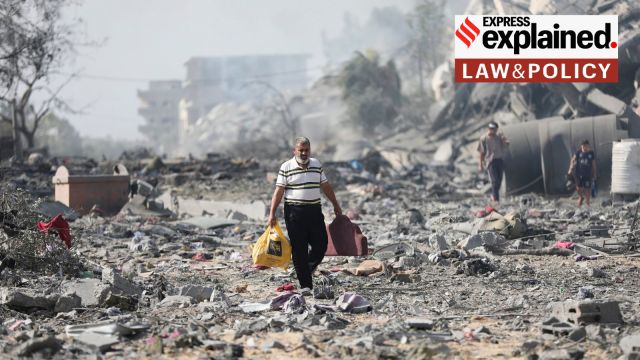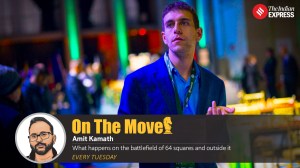Israel-Palestine conflict: How international humanitarian law views forced displacement and human shields
War throws up complex, highly polarising situations, which are in legally murky grounds. But at the core of international law is the prerogative to protect civilians.
 A Palestinian walks by buildings destroyed in Israeli bombardment on al-Zahra, on the outskirts of Gaza City, Oct. 20, 2023. (AP Photo/Ali Mahmoud)
A Palestinian walks by buildings destroyed in Israeli bombardment on al-Zahra, on the outskirts of Gaza City, Oct. 20, 2023. (AP Photo/Ali Mahmoud)
United States President Joe Biden, on Sunday (October 15) accused Palestinian militant group Hamas of using innocent Palestinians as human shields.
Israel has actually long accused Hamas of using human shields, or as Israeli PM Benjamin Netanyahu said, “targeting our civilians while hiding behind their civilians.”
Meanwhile, protests rage on in the Arab world and beyond, condemning the forced displacement of Gazans and other Palestinians by Israel.
This too has been a longstanding gripe among those behind the Palestinian cause. Arab leaders worry that such displacement will not only create a refugee influx in neighbouring countries, notably Egypt and Jordan, but also permanently put the Holy Land under Israeli occupation.
We look at what the two terms — ‘human shield’ and ‘forced displacement’ — mean, and how International Humanitarian Law (IHL) views them.
For latest updates, click here.
What are human shields?
The term ‘human shields’ is used in IHL with respect to civilians or other protected persons, whose presence or movement is aimed, or used to render military targets immune from military operations.
Important to understand here is that protected persons do not literally have to be used as a protective shield from, say against a hail of bullets, to be deemed as human shields. Even forcing them to remain near military targets or placing military targets in or adjacent to the same buildings as civilians is constituted as using human shields.
Also civilians are not the only protected persons in war. The Geneva Conventions and IHL protect the sick, wounded and shipwrecked not taking part in hostilities, prisoners of war and other detained persons, in addition to civilians and civilian objects.
How does IHL view human shields?
The use of human shields is considered a war crime and is banned as per Rule 97 of the IHL. It is also a highly looked-down-upon practice. At the same time, it is also prohibited to target/attack human shields.
“There’s really only one way in which a civilian [or any protected person] can lose immunity from attack … and that is direct participation in hostilities,” Janina Dill, co-director of the Oxford Institute for Ethics, Law, and Armed Conflict, told The NYT.
In the case of Gaza, things are complicated by the population density: there is simply no place in the besieged strip for Hamas combatants to exist without putting civilians in danger. However, regardless of whether Hamas intentionally uses civilian homes for military purposes, or does it simply out of necessity, it would not be legal for Israel to attack those targets.
What is forced displacement?
Last week, on Friday (13) morning, Israel ordered hundreds of thousands of civilians to evacuate from northern Gaza within 24 hours, apparently ahead of a planned ground invasion.
Under the Statute of the International Criminal Court, “ordering the displacement of the civilian population for reasons related to the conflict, unless the security of the civilians involved or imperative military reasons so demand,” constitutes forcible displacement.
How does IHL view forced displacement?
The International Committee of the Red Cross and the Norwegian Refugee Council described the order to “forcibly transfer” civilians as unlawful. “The Israeli military demand that 1.2 million civilians in northern Gaza relocate to its south within 24 hours, absent of any guarantees of safety or return, would amount to the war crime of forcible transfer,” said Jan Egeland, the secretary general of the Norwegian Refugee Council.
While warning civilians and non-combatants of legitimate military operations that may endanger them is in fact deemed necessary as far as possible, it is illegal to threaten people to leave.
“A threat is very different. A threat is when you inform the civilian population that you’re about to launch unlawful attacks, indiscriminate attacks, attacks that don’t take precautions for civilians, disproportionate attacks,” Adil Haque, an international law expert at Rutgers University, told The NYT.
Moreover, the phrase “absent of any guarantees of safety or return” is crucial here. Any displacement of civilians must be ‘temporary’, till the conflict ends, and only for their benefit. Prof Dill put it this way: the difference between evacuation and forced transfer depended on whether the act would “actually benefit the security of the civilians.”
(With inputs from The New York Times)





- 01
- 02
- 03
- 04
- 05
































